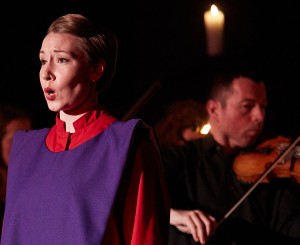Artistic director’s notes by Bevan Keating
Written for the Praeclara Messiah: Passion and Resurrection program, March 2016
Handel’s Messiah is one of the most beloved and well known large works in western music, but revisiting it often can be a challenge. How does one bring new life to music heard nearly every year? As stirring as the Hallelujah chorus is, as beautiful as the arias are, I felt that to present Parts II and III of Messiah as just another concert would do a great injustice to the story the music tells. In 2014, when we presented the Christmas portion of the oratorio in Messiah by Candlelight, we used candles and simple movement to tell the story of Christ’s entrance into the world. Here we build on those same concepts, but on a grander scale.
We have chosen to maintain the high contrasts of the work itself in our choice of ensembles. The thundering of the full choir in certain choruses provides a foil to the smaller, more intimate chorus that drives the narrative. The Praeclara vocal company merges with and emerges from the larger chorus, breaking the traditional barriers between singers and audience by putting aside their scores, sometimes even moving amongst the audience. The soloists, too, have become part of the story of the death and resurrection of Christ, singing more as characters than as narrators.
 Light continues to serve as a metaphor. As death of Christ approaches, the light dims until — with the last breath of the savior of mankind — it is extinguished entirely. Then with the resurrection, the chorus, Praeclara vocal company, and soloists are brought into sharp relief as the light of Christ reemerges from the darkness of death. The singers’ movements are simple so as not to detract from the severity of the story of Christ’s passion and resurrection with pageantry. At the same time, they reflect the journey portrayed in Handel’s choice of biblical text: from the uncertainty of the human experience to the surety of Christ’s salvation, from life to death, and from death to eternal life.
Light continues to serve as a metaphor. As death of Christ approaches, the light dims until — with the last breath of the savior of mankind — it is extinguished entirely. Then with the resurrection, the chorus, Praeclara vocal company, and soloists are brought into sharp relief as the light of Christ reemerges from the darkness of death. The singers’ movements are simple so as not to detract from the severity of the story of Christ’s passion and resurrection with pageantry. At the same time, they reflect the journey portrayed in Handel’s choice of biblical text: from the uncertainty of the human experience to the surety of Christ’s salvation, from life to death, and from death to eternal life.
Photo credits: Headshot of artistic director Bevan Keating (top); mezzo-soprano Kathryne Overturf and violinist Kiril Laskarov in Messiah: Passion and Resurrection (bottom). Photography by Kelly Hicks.


